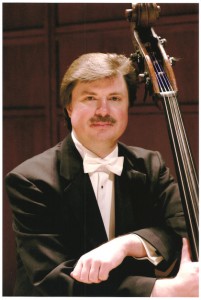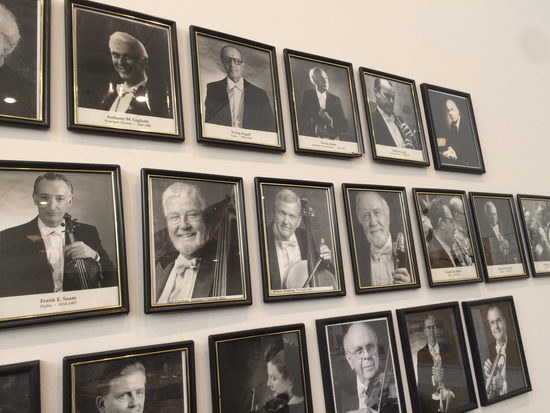
Photo credit: Michael Zirkle
As I reflect upon a decade of travel as ICSOM Chairman, it occurs to me it might be possible that I have visited more backstage orchestra lounges than all but a handful of negotiators. Often the personality of the musicians of the orchestra is represented in these lounges, and the musicians’ history as well. I have seen old program books, posters, promotional buttons, and even materials from previous negotiations. There are bulletin boards with ICSOM settlements, newspaper clippings, letters from supporters, and commendations from mayors and governors that honor the musicians.
Some lounges have a wall of portraits, with pictures of former members of the orchestra that have retired or passed away. These portrait walls serve to provide the musicians who performed in the orchestra for so many years with a permanent presence in the orchestra’s home. They are never forgotten, for they are always there.
I remember especially looking at the portraits of the former members of the Philadelphia Orchestra, backstage in the musicians’ lounge in Verizon Hall at the Kimmel Center for the Performing Arts. I recognized many mentors and friends, too many of them now absent.

Photo credit: Bob Grossman
I’ve always liked that traditional toast “to absent friends”, recited as a final glass is lifted in memory of departed friends and colleagues. I first learned it from a book by the great sportswriter Red Smith, in his collection of tributes to friends upon their passing.
The musicians’ lounge also contains some portraits of people who played an important role in ICSOM’s history. A picture of Irving Segall, who served as ICSOM Chair from 1974-1980, is there, along with Abe Torchinsky, for whom the ICSOM emeritus program is named.
Some walls in life are barriers, but these portrait walls in orchestra lounges are bridges. They honor the past as they strengthen the present, and they serve to ensure that those who have gone before will always be a part of the future.
Every orchestra undergoes a periodic generational shift, and that’s as it should be. As is often said, time only moves in one direction. Youth invigorates our orchestras and preserves the art form. Every musician is connected in some way to a magnificent past, as they studied with a great teacher, who studied with a great teacher before, who studied with a great teacher before that. In its most generous interpretation, the passing of time means that every musician today has at least a passing link to Beethoven, Brahms, Stravinsky, and Bernstein, along with thousands of legendary orchestral musicians.
Openings in our orchestras provide opportunities to welcome a new generation to our ranks. But sometimes when a colleague retires it can seem as if they are too quickly absent from our lives, and our present is weakened if we don’t remember, and celebrate, our past. It must be recognized by every new generation that there would be no orchestra for them to join if not for those who went before.
Some orchestras celebrate their former members perpetually. The Chicago Symphony Orchestra Alumni Association is very active, and the New York Philharmonic carefully maintains its archives, creating a website that provides countless hours of inspiration and education for the musicians who are performing in our orchestras today, as well as those who will join tomorrow.
Not every orchestra has a lounge backstage, as many perform in halls that are used by other performing organizations, or play in multiple halls to serve a wide community. But ways can still be found to celebrate former colleagues, and in doing so we will be forever connected to the achievements that preceded us. The opportunities for the next generation of musicians remain great, but as with all previous generations, those opportunities must be sought, protected and cultivated. The progress made thus far awaits new activism.
I have personally known all but three of the chairs of ICSOM. Sadly I never had the opportunity to meet Irving Segall, as he passed away in 2004. But I have read a number of his letters, and studied his work. A website dedicated to his memory describes him in this way:
“Men who came to the bargaining table pounding fists, ready to plunge political knives into the backs of their opponents, were met by Irv’s love for people and his compassionate nature—and they were calmed. They truly felt that they had been listened to and heard. He built bridges and lasting relationships – he made friends of everyone he met. Irv was devoted to justice. He had a very strong sense of what was ‘the right thing to do.’”
In the musicians’ lounge in Philadelphia, I spent a few moments looking at Mr. Segall’s picture on the musicians’ portrait wall. I was glad to see that a man so responsible for the growth of all our orchestras, and especially his own, is still a presence in the daily workplace of those who have succeeded him.
I hope more orchestras will create a portrait wall, or a place for pictures of those who have gone before. Every musician has earned a moment of honor from the current members of their orchestras, and everyone who has ever played in an ICSOM orchestra should be always be thought of as a colleague. In this way we can honor our past, serve our present, and welcome our future.
Note: This article was amended on 4/1/16 to correct the dates of Irving Segall





